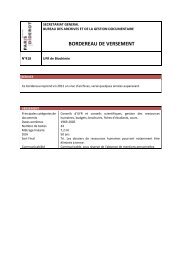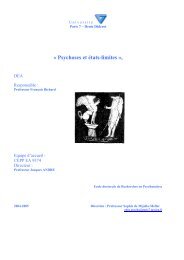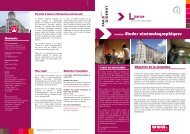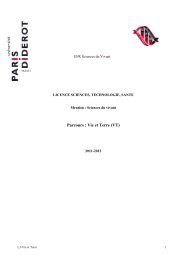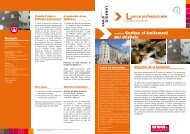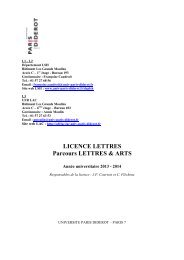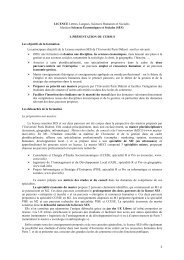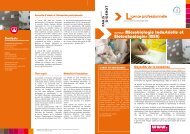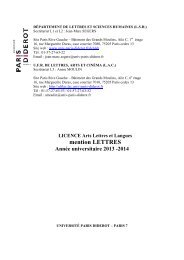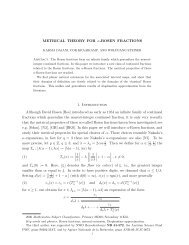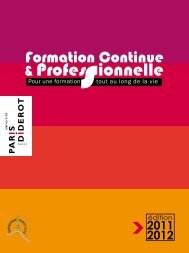Female Crafts: Women and Bricolage in late Georgian Britain
Female Crafts: Women and Bricolage in late Georgian Britain
Female Crafts: Women and Bricolage in late Georgian Britain
You also want an ePaper? Increase the reach of your titles
YUMPU automatically turns print PDFs into web optimized ePapers that Google loves.
<strong>Bricolage</strong><br />
WOMEN AND THINGS.<strong>in</strong>db 89 20/07/2009 15:40:33
WOMEN AND THINGS.<strong>in</strong>db 90 20/07/2009 15:40:33
5<br />
<strong>Female</strong> <strong>Crafts</strong>: <strong>Women</strong> <strong>and</strong> <strong>Bricolage</strong> <strong>in</strong><br />
Late <strong>Georgian</strong> Brita<strong>in</strong>, 1750–1820<br />
Ariane Fennetaux<br />
The recent upsurge of research on the gendered relationship to objects 1<br />
has paid particular attention to the eighteenth century as the period that<br />
witnessed both the emergence of “a world of goods” <strong>and</strong> the def<strong>in</strong>ition<br />
of <strong>in</strong>creas<strong>in</strong>gly separate spheres. 2 The so-called separation of the spheres,<br />
which emerged out of the eighteenth century, 3 <strong>in</strong>deed also corresponded<br />
to some extent to the allocation of the world of th<strong>in</strong>gs to women. In charge<br />
of the home <strong>and</strong> its day-to-day runn<strong>in</strong>g, women were responsible for the<br />
material world, as they purchased, managed, mended, arranged, <strong>and</strong><br />
decorated the objects of the <strong>in</strong>terior, while men’s preserve over public affairs<br />
but also abstraction <strong>and</strong> <strong>in</strong>tellectual pursuits was thereby reasserted. But<br />
if scholarship has by now well charted the territory of women as shoppers<br />
<strong>in</strong> the long eighteenth century, it is only very recently that some have<br />
started to show an <strong>in</strong>terest <strong>in</strong> an equally <strong>in</strong>terest<strong>in</strong>g, if neglected, aspect of<br />
women’s engagement with the world of th<strong>in</strong>gs, that is, their <strong>in</strong>volvement<br />
<strong>in</strong> the domestic fabrication of objects <strong>in</strong> the form of crafts <strong>and</strong> other “polite<br />
<strong>and</strong> useful arts.” 4<br />
Ann Berm<strong>in</strong>gham has underl<strong>in</strong>ed the rise of female amateur arts at<br />
the end of the eighteenth century. 5 Together with the more traditional<br />
embroidery, middle to upper-class ladies <strong>in</strong>creas<strong>in</strong>gly turned their h<strong>and</strong>s<br />
to japann<strong>in</strong>g, gild<strong>in</strong>g, fancywork, filigree, <strong>and</strong> shell-work. Neglected by<br />
historians <strong>and</strong> art historians alike, these activities are often regarded<br />
as mere pastimes that enabled women to while away their time while<br />
gild<strong>in</strong>g the cage <strong>in</strong> which they were expected to reside. 6 But crafts should<br />
not be dismissed as unequivocal expressions of women’s boredom <strong>in</strong> the<br />
domestic <strong>in</strong>terior; they are rich <strong>in</strong> ideological undertones which should be<br />
embraced. Unlike the morally suspect activity of shopp<strong>in</strong>g, these forms of<br />
engagement with objects were seen as virtuous <strong>and</strong> their encouragement<br />
WOMEN AND THINGS.<strong>in</strong>db 91 20/07/2009 15:40:33
92<br />
women <strong>and</strong> th<strong>in</strong>gs, 1750–1950<br />
participated <strong>in</strong> the promotion of domesticated fem<strong>in</strong><strong>in</strong>ity. Yet, far from<br />
be<strong>in</strong>g expressions of women’s mute acceptance of the gender role which<br />
these practices seemed to ascribe to them, crafts could be subverted <strong>and</strong><br />
used by women to their own ends. In the absence of precise concurr<strong>in</strong>g<br />
biographical <strong>in</strong>formation on their authors, ascrib<strong>in</strong>g specific mean<strong>in</strong>gs<br />
to the productions left by <strong>in</strong>dividual women from the past can prove<br />
hazardous. 7 This does not mean, however, that these crafts should not or<br />
cannot be subjected to <strong>in</strong>terpretation. In this essay the spread of female<br />
crafts <strong>in</strong> <strong>late</strong> <strong>Georgian</strong> Brita<strong>in</strong> will be studied <strong>in</strong> socio-anthropological<br />
terms <strong>and</strong> read <strong>in</strong> terms of the Levi-Straussian notion of bricolage, 8 that<br />
is, not as evidence of a base, m<strong>in</strong>dless, adherence to the material but of<br />
a mean<strong>in</strong>gful process whereby women not only expressed themselves as<br />
<strong>in</strong>dividuals but above all organized, appropriated, <strong>and</strong> made sense of the<br />
world around them.<br />
In this chapter, I first exam<strong>in</strong>e the spread of female crafts <strong>in</strong> Brita<strong>in</strong> <strong>and</strong><br />
highlight how these were often contrasted to potentially dangerous activities<br />
like shopp<strong>in</strong>g as a sort of moralized version of women’s engagement with<br />
the material. The ideological agenda that underlay those crafts will then<br />
be further explored <strong>and</strong> the encouragement of female crafts dedicated to<br />
decorat<strong>in</strong>g domestic objects will be shown to participate <strong>in</strong> the promotion<br />
of domesticated fem<strong>in</strong><strong>in</strong>ity. Yet despite this ideological construction, crafts<br />
such as japann<strong>in</strong>g or shell-work allowed women to experiment with fields<br />
<strong>and</strong> ideas that were traditionally associated with mascul<strong>in</strong>e pursuits. As<br />
such they should be seen as material strategies developed by women<br />
to appropriate through bricolage concerns not usually associated with<br />
fem<strong>in</strong><strong>in</strong>ity or domesticity—thereby bely<strong>in</strong>g any simplistic term to term<br />
opposition between private <strong>and</strong> public, male <strong>and</strong> female, but also between<br />
the material <strong>and</strong> the <strong>in</strong>tellectual.<br />
<strong>Women</strong> <strong>and</strong> Objects <strong>in</strong> <strong>Georgian</strong> Brita<strong>in</strong><br />
Needlework was the cornerstone of female education <strong>in</strong> the early-modern<br />
period. Young girls were taught to sew, stitch, <strong>and</strong> embroider from an early<br />
age <strong>and</strong> these skills were then practiced all through a woman’s life. Even if a<br />
gentlewoman was not expected to make the household’s l<strong>in</strong>en with her own<br />
h<strong>and</strong>s, she was still supposed to be able to supervise the work of her servants<br />
<strong>in</strong> that field <strong>and</strong> to take on decorative needlework such as embroidery. 9<br />
Eighteenth-century sources thus abound <strong>in</strong> examples of elite women be<strong>in</strong>g<br />
admired for <strong>and</strong> tak<strong>in</strong>g much pride <strong>in</strong> their needlework. The courtier<br />
Mary Delany was an expert at her needle, embroider<strong>in</strong>g the petticoats <strong>and</strong><br />
stomachers of her court mantuas <strong>in</strong> <strong>in</strong>tricate polychrome designs, while she<br />
also decorated footstools <strong>and</strong> chairs for her house or as presents to friends. 10<br />
WOMEN AND THINGS.<strong>in</strong>db 92 20/07/2009 15:40:34
Ariane Fennetaux 93<br />
In the eighteenth century, the domestic production of middle-class <strong>and</strong><br />
elite women was not restricted to dress or to embroidery. Techniques such<br />
as japann<strong>in</strong>g, gild<strong>in</strong>g, fancywork, filigree, <strong>and</strong> shell-work were but a few<br />
of the useful arts that <strong>Georgian</strong> women practiced alongside the traditional<br />
activity of needlework. Mrs Delany, who was particularly prolific, practiced<br />
japann<strong>in</strong>g as well as shell-work with which she decorated picture frames or<br />
brackets, but also completed more ambitious projects like grottoes <strong>and</strong> the<br />
decorations of whole rooms us<strong>in</strong>g shells <strong>in</strong> imitation of stucco or carv<strong>in</strong>g.<br />
Her private correspondence testifies to her relentless <strong>in</strong>dustry: “I have<br />
worked like a dragon this week at my lustre <strong>and</strong> completed it on Thursday,”<br />
Mrs Delany wrote to her sister <strong>in</strong> 1750. 11 She was not alone. Lady Hertford<br />
similarly wrote of women’s <strong>in</strong>dustry: “with<strong>in</strong> doors we amuse ourselves<br />
… <strong>in</strong> gild<strong>in</strong>g picture frames, <strong>and</strong> other small th<strong>in</strong>gs, this is so much <strong>in</strong><br />
fashion with us at present that I believe if our patience <strong>and</strong> pockets hold<br />
out, we shall gild all the cornices, table <strong>and</strong> chairs <strong>and</strong> stool about the<br />
house.” 12 Characteristic of <strong>Georgian</strong> women’s dedicated <strong>in</strong>volvement <strong>in</strong><br />
domestic production was the scene witnessed by Lord Aldoborough on<br />
his return to Belan House where he found “Louisa W<strong>in</strong>gfield at work,<br />
Martha pa<strong>in</strong>t<strong>in</strong>g a card table, Emily at other work … [<strong>and</strong>] the grotto go<strong>in</strong>g<br />
on … [with the arrival of shell] from Waterford.” 13 In the first decades of<br />
the n<strong>in</strong>eteenth century, this <strong>in</strong>defatigable production could reach almost<br />
silly extremes accord<strong>in</strong>g to some. In a letter written <strong>in</strong> 1826, Carol<strong>in</strong>e Anne<br />
Bowles expressed her bewilderment at the unremitt<strong>in</strong>g <strong>in</strong>dustry of her<br />
female contemporaries:<br />
Heaven have mercy on us! All womank<strong>in</strong>d is whirl<strong>in</strong>g around <strong>in</strong> a vortex<br />
of religious dissipation … One lady’s draw<strong>in</strong>g room is full of little charity<br />
boxes, placed here <strong>and</strong> there amongst the ornamental litter; another keeps<br />
a stall of trumpery knick-knacks—“ladies’ work”—to lay her visitors under<br />
contribution; another asks you to work for her (audacious!) <strong>and</strong> then a whole<br />
bevy of damsels sit congregated together, past<strong>in</strong>g <strong>and</strong> pa<strong>in</strong>t<strong>in</strong>g, sew<strong>in</strong>g<br />
<strong>and</strong> gild<strong>in</strong>g <strong>and</strong> what not to get up a booth for the next religious fair. 14<br />
The success of those crafts is also evidenced by the grow<strong>in</strong>g publication of<br />
manuals help<strong>in</strong>g women to master those techniques. Books <strong>in</strong>struct<strong>in</strong>g women<br />
<strong>in</strong>to the art of japann<strong>in</strong>g started to appear at the end of the seventeenth century.<br />
A Treatise of Japann<strong>in</strong>g <strong>and</strong> Varnish<strong>in</strong>g by John Stalker <strong>and</strong> George Parker,<br />
published <strong>in</strong> 1688, thus conta<strong>in</strong>ed tips as well as a series of pr<strong>in</strong>ts to be used<br />
to decorate objects such as “the lid of a powder box,” “the lid of a patch box,”<br />
“a St<strong>and</strong>ish for pen, <strong>in</strong>k <strong>and</strong> paper,” or “a frame for a look<strong>in</strong>g glass.” 15 In the<br />
course of the century, various manuals specifically addressed to ladies were<br />
published tell<strong>in</strong>g their readers how to pa<strong>in</strong>t <strong>and</strong> cut pr<strong>in</strong>ts, glue or transfer<br />
them onto any object before varnish<strong>in</strong>g it. The Accomplish’d <strong>Female</strong> Instructor,<br />
published <strong>in</strong> 1704, thus had a whole chapter on the art of japann<strong>in</strong>g <strong>in</strong> which<br />
WOMEN AND THINGS.<strong>in</strong>db 93 20/07/2009 15:40:34
94<br />
women <strong>and</strong> th<strong>in</strong>gs, 1750–1950<br />
could be read: “<strong>and</strong> by this rule you may … pa<strong>in</strong>t l<strong>and</strong>skips [sic] with woods,<br />
cottages, rivers, trees, hills, sun, moon, stars or the like on tables, st<strong>and</strong>s,<br />
cab<strong>in</strong>ets, scrutores [sic], look<strong>in</strong>g glasses, chests of drawers, or any smooth<br />
th<strong>in</strong>g as you shall see fit.” 16 A manual published <strong>in</strong> 1730 under the name of<br />
Mrs Artlove “at the request of several ladies of dist<strong>in</strong>ction” was specifically<br />
dedicated to “the art of Japann<strong>in</strong>g, varnish<strong>in</strong>g, pollish<strong>in</strong>g [sic] <strong>and</strong> gild<strong>in</strong>g”<br />
<strong>and</strong> had all sorts of recipes for glues, varnishes <strong>and</strong> colors. 17 The <strong>in</strong>troduction<br />
to The Ladies’ Amusement or the Whole Art of Japann<strong>in</strong>g Made Easy, published <strong>in</strong><br />
1760, shows the peak of success that such fem<strong>in</strong><strong>in</strong>e pastimes had reached by<br />
the second half of the century:<br />
The art of japann<strong>in</strong>g <strong>and</strong> decorat<strong>in</strong>g with various designs has prevailed<br />
so much of <strong>late</strong> from the superb cab<strong>in</strong>et to the smallest article of toilet,<br />
that it is needless to apologize for the publication of a work, which seems<br />
calcu<strong>late</strong>d at once to serve every purpose of compositions for this use. 18<br />
“How-to” manuals multiplied, diversified, <strong>and</strong> democratized as the<br />
eighteenth century went on: women could not only learn to prepare glues,<br />
varnishes, concoct all sorts of t<strong>in</strong>ts <strong>and</strong> dyes, decorate objects with pr<strong>in</strong>ts<br />
or gild, but they also became <strong>in</strong>structed <strong>in</strong> filigree, shell–work, <strong>and</strong> could<br />
even learn how to make wax or gum flowers. The Young Ladies’ School of<br />
Arts, Conta<strong>in</strong><strong>in</strong>g a Great Variety of Practical Receipts <strong>in</strong> Gum Flowers, Filligree,<br />
Japann<strong>in</strong>g, Shellwork, Gild<strong>in</strong>g, Pa<strong>in</strong>t<strong>in</strong>g …, published by Hannah Robertson <strong>in</strong><br />
1767 <strong>in</strong> Ed<strong>in</strong>burgh, is typical of such manuals. It gave tips on how to decorate<br />
with filigree “pictures or glass frames,” provided recipes “to make varnish<br />
of any colour for the dress<strong>in</strong>g boxes etc.,” <strong>and</strong> expla<strong>in</strong>ed how “various sorts<br />
of flowers may be formed from shells” to make “beautiful festoons, brackets,<br />
picture-frames etc.” 19 All the tips for such pastimes were also <strong>in</strong>cluded <strong>in</strong><br />
advice literature which compiled recipes for anyth<strong>in</strong>g from gild<strong>in</strong>g <strong>and</strong><br />
japann<strong>in</strong>g to mak<strong>in</strong>g jellied eels or prepar<strong>in</strong>g cosmetics <strong>and</strong> physics.<br />
Indeed, rather tell<strong>in</strong>gly <strong>in</strong> some manuals, Japann<strong>in</strong>g, shell-work, <strong>and</strong><br />
filigree were often bracketed with traditional domestic arts such as cook<strong>in</strong>g<br />
or mak<strong>in</strong>g preserves. The conflation is symptomatic of the ideological<br />
agenda that underlay these activities. As opposed to women’s fateful<br />
profligacy, home production was a socially acceptable, morally endorsed<br />
expression of women’s materialism. If eighteenth-century women’s role as<br />
shoppers made them a prime target for satirists <strong>and</strong> moralists alike, who<br />
derided their supposed materialistic acquisitiveness <strong>and</strong> often portrayed<br />
them as threats to the good economy of the household, <strong>and</strong> <strong>in</strong>deed of the<br />
country, their <strong>in</strong>volvement with the material upkeep <strong>and</strong> beautify<strong>in</strong>g of<br />
the household <strong>in</strong> the form of mak<strong>in</strong>g up, embroider<strong>in</strong>g or decorat<strong>in</strong>g was<br />
seen as commendable <strong>and</strong> virtuous. Because of the desirable values which<br />
these crafts encoded, they were encouraged <strong>and</strong> therefore participated <strong>in</strong><br />
foster<strong>in</strong>g domesticated fem<strong>in</strong><strong>in</strong>ity.<br />
WOMEN AND THINGS.<strong>in</strong>db 94 20/07/2009 15:40:34
The Gild<strong>in</strong>g of the Cage?<br />
Ariane Fennetaux 95<br />
Embroidery has been shown to be openly associated to the <strong>in</strong>culcation of<br />
fem<strong>in</strong><strong>in</strong>e virtue. 20 In the eighteenth century, samplers, meant to tra<strong>in</strong> young<br />
girls <strong>in</strong> the various stitches of embroidery, often did so by sett<strong>in</strong>g them to<br />
embroider moralistic or biblical scenes extoll<strong>in</strong>g the values of obedience.<br />
Virtuous mottoes, quotes from the Scriptures or the Lord’s Prayer<br />
were thus embroidered by young girls <strong>in</strong>stead of alphabets or rows of<br />
decorative stitches as <strong>in</strong> the previous century. 21 Unsurpris<strong>in</strong>gly eighteenthcentury<br />
domestic conduct books praised needlework <strong>and</strong> contrasted it to<br />
gambl<strong>in</strong>g or go<strong>in</strong>g to assemblies, as it kept women <strong>in</strong> their proper spheres:<br />
that of home. James Fordyce, the epitome of such ideological discourses,<br />
encouraged women to carry out needlework <strong>and</strong> be “simple enough<br />
… to be <strong>in</strong> love with home <strong>and</strong> seek their happ<strong>in</strong>ess <strong>in</strong> their duty.” 22 In<br />
her Practical Education published <strong>in</strong> 1798, moralist Maria Edgeworth has<br />
a whole chapter on female accomplishments <strong>in</strong> which she wrote that<br />
women:<br />
should rather be encouraged, by all means to cultivate those tastes which can<br />
attach them to their home <strong>and</strong> which can preserve them from the miseries of<br />
dissipation. Every sedentary occupation must be valuable to those who are to lead<br />
sedentary lives; <strong>and</strong> every art, however trifl<strong>in</strong>g <strong>in</strong> itself, which tends to enliven <strong>and</strong><br />
embellish domestic life, must be advantageous, not only to the female sex, but to<br />
society <strong>in</strong> general. As far as accomplishments can contribute to all or any of these<br />
excellent purposes, they must be just objects of attention <strong>in</strong> early education. 23<br />
<strong>Crafts</strong>, whether they be fancywork, shell-work, or japann<strong>in</strong>g, were thus<br />
regarded a woman’s proper ambition: the house was the place for female selffulfilment.<br />
In an essay published <strong>in</strong> 1810 <strong>and</strong> <strong>in</strong> which he extolled fancywork<br />
(another name for Japann<strong>in</strong>g), Rudolph Ackerman <strong>in</strong>sisted on the supposed<br />
“good consequence” of such useful pastime:<br />
Let us for a moment reflect on the good consequence, which a fondness for fancy<br />
work is calcu<strong>late</strong>d to produce <strong>in</strong> future. Ladies who have once engaged <strong>in</strong> this<br />
<strong>in</strong>nocent <strong>and</strong> amus<strong>in</strong>g occupation, which daily affords such abundant scope for<br />
new <strong>in</strong>ventions, will never rel<strong>in</strong>quish it, from ornamental subjects they are led<br />
imperceptibly to the mak<strong>in</strong>g of useful articles so that it is no uncommon th<strong>in</strong>g<br />
to enter a draw<strong>in</strong>g, breakfast or d<strong>in</strong><strong>in</strong>g room, where the fire screens, card racks,<br />
chimney ornaments, boxes, picture frames <strong>and</strong> a variety of other objects are made,<br />
pa<strong>in</strong>ted, <strong>and</strong> decorated by the <strong>in</strong>genious mistress of the house or her daughters. 24<br />
The equation between fem<strong>in</strong><strong>in</strong>e virtue <strong>and</strong> home-made objects was <strong>in</strong>scribed <strong>in</strong><br />
the very production of those objects s<strong>in</strong>ce it often encapsu<strong>late</strong>d the paramount<br />
values of domesticated fem<strong>in</strong><strong>in</strong>ity such as a woman’s supposed superior taste<br />
<strong>in</strong> home decoration but also thrift, patience, <strong>and</strong> discipl<strong>in</strong>e.<br />
WOMEN AND THINGS.<strong>in</strong>db 95 20/07/2009 15:40:34
96<br />
women <strong>and</strong> th<strong>in</strong>gs, 1750–1950<br />
In manuals, crafts were sometimes presented as the thrifty alternative<br />
to buy<strong>in</strong>g overpriced ready-made objects from shops. The author of The<br />
Ladies’ Amusement or the Whole Art of Japann<strong>in</strong>g Made Easy thus wrote: “the<br />
follow<strong>in</strong>g directions well attended to, will not only furnish an agreeable<br />
amusement but enable any one … to embellish a pla<strong>in</strong> surface with<br />
ornaments superior to those we purchase at so great an expense from<br />
India <strong>and</strong> elsewhere.” 25 Instead of giv<strong>in</strong>g <strong>in</strong> to their potentially ru<strong>in</strong>ous<br />
acquisitiveness <strong>and</strong> what was seen as women’s <strong>in</strong>ord<strong>in</strong>ate desire for<br />
always more objects, such transformative crafts (pla<strong>in</strong> pieces of material<br />
were embroidered, pr<strong>in</strong>ts were made <strong>in</strong>to snuff-boxes, shells <strong>in</strong>to picture<br />
frames or brackets) tamed women <strong>in</strong>to good domestic economy based on<br />
<strong>in</strong>dustry <strong>and</strong> thrift. 26<br />
Rozsika Parker has shown that the m<strong>in</strong>uteness of needlework, the<br />
patient stitch-by-stitch copy<strong>in</strong>g <strong>in</strong>to the drawn pattern of the embroidered<br />
design, made the practice of needlework <strong>in</strong>tr<strong>in</strong>sically discipl<strong>in</strong><strong>in</strong>g. 27 Similar<br />
concentration, patience, <strong>and</strong> order were required by the other female<br />
crafts. Filigree, for <strong>in</strong>stance, dem<strong>and</strong>ed many different delicate operations<br />
s<strong>in</strong>ce sheets of paper had to be first t<strong>in</strong>ted <strong>in</strong> several colors, glazed, cut <strong>in</strong><br />
t<strong>in</strong>y strips that then had to be carefully rolled up <strong>and</strong> delicately p<strong>in</strong>ned<br />
onto the object to form <strong>in</strong>tricate designs. For all these, as for japann<strong>in</strong>g,<br />
it was “necessary to be very particular <strong>and</strong> careful <strong>in</strong> each operation” as<br />
a manual warned. 28 Shell-work was no less particular: clean<strong>in</strong>g shells,<br />
sort<strong>in</strong>g them accord<strong>in</strong>g to type, size, or color, varnish<strong>in</strong>g or pa<strong>in</strong>t<strong>in</strong>g them,<br />
<strong>and</strong> glu<strong>in</strong>g them to make flowers or other decorations were delicate, timeconsum<strong>in</strong>g<br />
tasks that required attentiveness <strong>and</strong> dedication. The shell vase<br />
of flowers made by Mrs Bonnel <strong>and</strong> her daughter <strong>in</strong> 1779–81, kept <strong>in</strong> the<br />
Victoria <strong>and</strong> Albert Museum, gives some idea of the time <strong>and</strong> m<strong>in</strong>uteness<br />
of some undertak<strong>in</strong>gs (see Figure 5.1). Some creations took several years.<br />
The Duchess of Richmond’s shell grotto, for <strong>in</strong>stance, took her <strong>and</strong> her<br />
daughter seven years to complete. So all female crafts to some extent can<br />
be regarded as encod<strong>in</strong>g the values of discipl<strong>in</strong>e <strong>and</strong> order associated with<br />
the domesticated woman. Essentially home-ground, these activities kept<br />
women at home for long hours <strong>and</strong> thus physically conta<strong>in</strong>ed them <strong>in</strong> the<br />
privacy of the house. Some of the artifacts created were even a sort of mise<br />
en abyme of this domestication, as they represented houses <strong>and</strong> sometimes<br />
<strong>in</strong>cluded female figures. Together with virtuous mottoes on obedience <strong>and</strong><br />
piety, eighteenth-century samplers were often embroidered with visual<br />
motifs such as houses, pets, <strong>and</strong> well-ma<strong>in</strong>ta<strong>in</strong>ed gardens that symbolized<br />
domesticity, fidelity, <strong>and</strong> controlled nature. 29 In a typical example of such<br />
work dat<strong>in</strong>g from 1789 (see Figure 5.2), the little girl has embroidered<br />
some pious verse prais<strong>in</strong>g dutiful obedience to <strong>and</strong> imitation of her<br />
mother—<strong>in</strong> particular as regards needlework—while the bottom part<br />
shows an eighteenth-century house, a tree cut <strong>in</strong> a perfect triangle, potted<br />
WOMEN AND THINGS.<strong>in</strong>db 96 20/07/2009 15:40:34
5.1 Mrs Bonnel Beal <strong>and</strong> Miss Bonnel Harvey, shellwork vase, circa 1779–81<br />
(89 × 54 × 36 cm). Victoria <strong>and</strong> Albert Museum, <strong>in</strong>v: W 70. 1981.<br />
© Victoria <strong>and</strong> Albert Museum, London. Reproduced by permission<br />
WOMEN AND THINGS.<strong>in</strong>db 97 20/07/2009 15:40:35
98<br />
women <strong>and</strong> th<strong>in</strong>gs, 1750–1950<br />
5.2 Mary Ann Body, Sampler. Wool embroidered with silk, 1789 (35.6 × 31.75 cm).<br />
Victoria <strong>and</strong> Albert Museum, <strong>in</strong>v: T. 292-1916. © Victoria <strong>and</strong> Albert Museum,<br />
London. Reproduced by permission<br />
plants, a couple of parrots <strong>and</strong> a pet dog. 30 Some shell-work creations<br />
similarly represent female domesticity. In 1757 Anne Reckless Emlen, a<br />
Philadelphian woman, built a m<strong>in</strong>iature house surmounted by her <strong>in</strong>itials<br />
<strong>and</strong> the date (see Figure 5.3) us<strong>in</strong>g shells, gum, <strong>and</strong> paper. 31 The long hours<br />
it must have kept its author at home, the identification of the house by<br />
the woman’s <strong>in</strong>itials <strong>in</strong>scribed on its pediment, <strong>and</strong> the presence of three<br />
female dolls about the house turn the piece <strong>in</strong>to a powerful representation<br />
of the domestic reality of eighteenth-century women’s lives.<br />
WOMEN AND THINGS.<strong>in</strong>db 98 20/07/2009 15:40:36
Ariane Fennetaux 99<br />
5.3 Ann Reckless Emlen’s House. Shell, gum <strong>and</strong> paper, 1757, Stenton. Courtesy<br />
of the National Society of The Colonial Dames of America <strong>in</strong> the Commonwealth of<br />
Pennsylvania at STENTON. Reproduced by permission<br />
Yet, although they were centered on the aesthetization of objects <strong>in</strong> the<br />
domestic space, female crafts did not quite conf<strong>in</strong>e women to the house<br />
s<strong>in</strong>ce procur<strong>in</strong>g the materials needed for their various projects took women<br />
outside of the domestic sphere. A real market for amateur arts appeared <strong>in</strong><br />
Brita<strong>in</strong> towards the end of the eighteenth century. 32 “The N<strong>in</strong>e Liv<strong>in</strong>g Muses<br />
of Great Brita<strong>in</strong>” that opened <strong>in</strong> London <strong>in</strong> 1779, or Rudolph Ackerman’s<br />
famous Repository of the Arts that was situated on 101 Str<strong>and</strong>, were two<br />
examples of such specialty shops <strong>in</strong> which women could buy <strong>in</strong>ks, varnishes,<br />
WOMEN AND THINGS.<strong>in</strong>db 99 20/07/2009 15:40:37
100<br />
women <strong>and</strong> th<strong>in</strong>gs, 1750–1950<br />
gum Arabic, brushes or pr<strong>in</strong>ts for their various artistic endeavors. 33 Also,<br />
even though domestic creations were sometimes contrasted to ru<strong>in</strong>ous<br />
acquisitiveness for ready-made objects, some of the materials <strong>in</strong>volved <strong>in</strong><br />
the crafts were actually rather costly: the shells required for shell-work<br />
<strong>in</strong> particular were very expensive. Mrs Delany made several comments<br />
on the cost of shells <strong>in</strong> her correspondence. 34 The gr<strong>and</strong>er projects such<br />
as grotto work or the à la ronde house built by the Parm<strong>in</strong>ster sisters <strong>in</strong><br />
the last years of the eighteenth century required thous<strong>and</strong>s of shells <strong>and</strong><br />
were therefore extremely costly ventures. 35 Moreover, these arts actually<br />
enabled women to escape the conf<strong>in</strong>es of the house s<strong>in</strong>ce some productions<br />
received public recognition when grottoes attracted curious visitors, for<br />
<strong>in</strong>stance, or when the productions of some women were shown <strong>in</strong> public<br />
exhibitions, as those of a woman named Mrs Dards who had two exhibitions<br />
<strong>in</strong> London <strong>in</strong> 1800 <strong>and</strong> 1802, for which catalogues were published <strong>and</strong><br />
sold. 36<br />
So the female crafts that developed at the end of the eighteenth century<br />
should not merely be seen as a sign of women bl<strong>in</strong>dly adher<strong>in</strong>g to the<br />
values of good economy <strong>and</strong> domesticity that gender constructions were<br />
ascrib<strong>in</strong>g to them. Indeed, crafts could be appropriated by women, often<br />
allow<strong>in</strong>g them to trespass <strong>in</strong>to fields not traditionally associated with<br />
them.<br />
<strong>Women</strong> <strong>and</strong> <strong>Bricolage</strong><br />
Rozsika Parker’s research on needlework has shown that despite its openly<br />
pedagogical <strong>and</strong> discipl<strong>in</strong><strong>in</strong>g agenda, embroidery could be subverted<br />
by women to their own ends. An 1830 sampler kept <strong>in</strong> the Victoria <strong>and</strong><br />
Albert Museum provides a vivid illustration of this subversion. 37 Although<br />
the piece of embroidery conta<strong>in</strong>s references to obedience <strong>and</strong> piety,<br />
these are not formulaic <strong>and</strong> impersonal but are <strong>in</strong>tegrated <strong>in</strong> a poignant<br />
autobiographical narrative of its author’s ill treatment when <strong>in</strong> service,<br />
where she expresses <strong>in</strong> heartfelt terms her moral <strong>and</strong> spiritual suffer<strong>in</strong>gs.<br />
Similarly, the female crafts that developed at the end of the eighteenth<br />
century could be appropriated by their authors to express th<strong>in</strong>gs that<br />
went beyond conformity to gender constructions. But if they did provide<br />
a means of personal expression to women, the non-verbal quality of these<br />
crafts makes <strong>in</strong>terpretation of <strong>in</strong>dividual pieces but tentative. 38 What can<br />
be approached are the wider social issues at stake <strong>in</strong> those activities <strong>and</strong> <strong>in</strong><br />
particular how crafts could be ways for women to ga<strong>in</strong> access to spheres of<br />
activities that were not otherwise readily open to them.<br />
Indeed, not restricted to the socially acceptable idea of women’s <strong>in</strong>terest<br />
for tasteful <strong>in</strong>terior decoration, needlework, shell-work or Japann<strong>in</strong>g were<br />
WOMEN AND THINGS.<strong>in</strong>db 100 20/07/2009 15:40:37
Ariane Fennetaux 101<br />
also <strong>in</strong>direct ways for women to trespass <strong>in</strong>to a traditionally male preserve,<br />
that of science, especially the apparently benign area of natural science.<br />
Needlework <strong>and</strong> botany are a good illustration of this: because a knowledge<br />
of flowers was encouraged <strong>in</strong> women whom it provided with pretty, varied<br />
subjects for embroidery, botany was one of the earliest fields of science<br />
<strong>in</strong> which women started to ga<strong>in</strong> some k<strong>in</strong>d of public recognition for their<br />
endeavors. 39 Priscilla Wakefield’s 1796 An Introduction to Botany, which was<br />
based on L<strong>in</strong>naeus’s classification of plants, is an example of the way this<br />
branch of science was becom<strong>in</strong>g acceptable for women by the end of the<br />
century. 40 Despite discourses pitt<strong>in</strong>g the aesthetic (female) approach aga<strong>in</strong>st<br />
the scientific (male) approach to flowers, crafts could overlap <strong>in</strong>to science,<br />
as acknowledged by the great eighteenth-century naturalist Joseph Banks<br />
himself who thought that Mrs Delany’s cut paper flowers were so exact that<br />
they could be used by the naturalist to describe <strong>and</strong> classify specimens. 41<br />
As with flowers, there seems to have been the same attempt <strong>in</strong> some<br />
discourses to ma<strong>in</strong>ta<strong>in</strong> a dichotomy between the aesthetic <strong>and</strong> scientific<br />
qualities of shells: Griffith Hughes, who wrote The Natural History of Barbados<br />
<strong>in</strong> 1750, thus somewhat ambiguously defended shell-work aga<strong>in</strong>st accusations<br />
of uselessness by prais<strong>in</strong>g its artistic value, thereby also reassert<strong>in</strong>g mascul<strong>in</strong>e<br />
preserve on the scientific knowledge of shells. He starts his chapter on shells:<br />
“It may be expected that I should here consider these beautiful productions<br />
<strong>in</strong> a physical light, <strong>and</strong> as they are a curiosity belong<strong>in</strong>g to the cab<strong>in</strong>ets of<br />
the Virtuosi: yet I shall beg leave to speak of them, as they contribute to the<br />
amusement of the ladies”; 42 while pitt<strong>in</strong>g one aga<strong>in</strong>st the other, he still writes<br />
his scientific description of exotic shells, hop<strong>in</strong>g that not only “the <strong>in</strong>quisitive<br />
philosopher” but also “the female artificer” will benefit from it. 43 Of course,<br />
men’s conchological pursuits, although considered as serious <strong>and</strong> scientific,<br />
were not devoid of ambiguity themselves as far as the decorative, aesthetic<br />
aspect of shells went, as illustrated by the p<strong>late</strong>s of the catalogue of Dutch<br />
apothecary Albert Seba’s impressive collection of natural curiosities published<br />
between 1734 <strong>and</strong> 1765, <strong>in</strong> which shells are sometimes found arranged <strong>in</strong><br />
festoons <strong>and</strong> figures that are very rem<strong>in</strong>iscent of shell-work (see Figure 5.4). 44<br />
The scientific <strong>and</strong> aesthetic could overlap. Conversely, women showed an<br />
<strong>in</strong>terest <strong>in</strong> shells, not only for the aesthetic quality of their shapes or colors, but<br />
also as naturalists who collected them <strong>in</strong> cab<strong>in</strong>ets like their male counterparts,<br />
appreciated their <strong>in</strong>f<strong>in</strong>ite variety, <strong>and</strong> sometimes knew their scientific names. 45<br />
And as with needlework that opened the door to botany, shell-work can be<br />
seen as hav<strong>in</strong>g provided a socially acceptable <strong>in</strong>terest <strong>in</strong> shells that enabled<br />
some women, <strong>in</strong> the first decades of the n<strong>in</strong>eteenth century, to ga<strong>in</strong> access to<br />
conchology. 46<br />
Needlework, shell-work or <strong>in</strong>deed japann<strong>in</strong>g, some of whose p<strong>late</strong>s<br />
<strong>in</strong>cluded entomology illustrations, 47 could thus comb<strong>in</strong>e an aesthete’s <strong>in</strong>terest<br />
<strong>and</strong> a naturalist’s curiosity <strong>and</strong> they were thought by some to be as valid as any<br />
WOMEN AND THINGS.<strong>in</strong>db 101 20/07/2009 15:40:37
102<br />
women <strong>and</strong> th<strong>in</strong>gs, 1750–1950<br />
5.4 Albertus Seba, Locupletissimi rerum naturalium thesauri accurata descriptio, et<br />
<strong>in</strong>conibus artificiosissimis expressio, per universam physices historiam, vol. 3, p<strong>late</strong> XXXVI.<br />
© British Library Board. All Rights Reserved 43.K.3. Reproduced by permission<br />
heroic (<strong>and</strong> therefore also mascul<strong>in</strong>e) pursuit. Lady Mary Wortley Montagu<br />
thus wrote <strong>in</strong> 1759: “I confess I am woman enough to th<strong>in</strong>k the naturalist who<br />
searches after variegated butterflies, or even the lady who adorns her grotto<br />
with shades of shells … throw away time <strong>in</strong> a more rational manner than any<br />
hero, ancient or modern.” 48<br />
Although somewhat offh<strong>and</strong>edly, some women went as far as actually<br />
compar<strong>in</strong>g their shell-work endeavors to the feats of arms of military<br />
comm<strong>and</strong>ers. In 1757, after the glorious victories of Prussia over France<br />
<strong>and</strong> Austria at the outset of the Seven Years’ War, Mary Delany wrote to her<br />
sister:<br />
The pr<strong>in</strong>ce of Bevern’s success follow<strong>in</strong>g the K<strong>in</strong>g of Prussia’s has raised all<br />
our spirits. I wish to god our own countrymen made as good a figure.<br />
Lady Andover <strong>and</strong> I have entered on a piece of work to surprise the Duchess of<br />
Portl<strong>and</strong> on her return, which is flourish<strong>in</strong>g. It is a frame of a picture, with shell<br />
WOMEN AND THINGS.<strong>in</strong>db 102 20/07/2009 15:40:38
Ariane Fennetaux 103<br />
work <strong>in</strong> the manner of the frame to your ch<strong>in</strong>a case; <strong>and</strong> we are as eager <strong>in</strong> sort<strong>in</strong>g<br />
our shells, plac<strong>in</strong>g them <strong>in</strong> their proper degrees, mak<strong>in</strong>g l<strong>in</strong>es, ramparts, as the<br />
K<strong>in</strong>g of Prussia <strong>in</strong> the midst of his army, <strong>and</strong> as fond of our own compositions. 49<br />
Although the comparison between the battalions <strong>and</strong> the rows of shells may<br />
strike us as a somewhat flippant piece of witticism not to be taken at face<br />
value, it draws attention to another way <strong>in</strong> which female crafts <strong>in</strong>tersected<br />
with traditionally mascul<strong>in</strong>e concerns: both japann<strong>in</strong>g <strong>and</strong> shell-work were<br />
closely l<strong>in</strong>ked to the country’s foreign affairs <strong>and</strong> more particularly to the<br />
expansion of Brita<strong>in</strong>’s overseas empire.<br />
Most prized among shells were exotic specimens that had unusual shapes<br />
<strong>and</strong> vivid colors. These were imported or brought back from the Caribbean<br />
by friends <strong>and</strong> relatives, <strong>in</strong> particular, navy officers. In her correspondence,<br />
Mary Delany thus rejoiced to have been <strong>in</strong>troduced <strong>in</strong> Bath to “a seafar<strong>in</strong>g<br />
capta<strong>in</strong> called Edwards who has promised me a box of shells from Gu<strong>in</strong>ea,<br />
Jamaica etc,” 50 while the splendid specimens found on the grotto of the<br />
third Duchess of Richmond <strong>in</strong> Goodwood depended for a great part on<br />
her l<strong>in</strong>ks to officers <strong>in</strong> the British navy. 51 In 1739, Capta<strong>in</strong> Knowles of HMS<br />
Diamond brought a shipload of shells back to the Dukes of Richmond<br />
<strong>and</strong> Bedford from one of his trips to the South Seas which provided shells<br />
for the splendid grotto. 52 Thus although apparently trivial, fem<strong>in</strong><strong>in</strong>e, <strong>and</strong><br />
domestic, the fashion for shell-work that spread <strong>in</strong> Brita<strong>in</strong> <strong>in</strong> the eighteenth<br />
<strong>and</strong> n<strong>in</strong>eteenth centuries cannot be separated from the country’s imperial<br />
expansion.<br />
Japann<strong>in</strong>g can similarly be l<strong>in</strong>ked to the expansion of Brita<strong>in</strong>’s empire as<br />
the technique was <strong>in</strong>spired by lacquer objects first imported <strong>in</strong>to the country<br />
by the East India Company. Many pr<strong>in</strong>ts provided <strong>in</strong> japann<strong>in</strong>g manuals had<br />
an exotic feel to them s<strong>in</strong>ce, as a treatise expla<strong>in</strong>ed, with those Ch<strong>in</strong>ese <strong>and</strong><br />
Indian designs “greater liberties may be taken because luxuriance of fancy<br />
recommends their production more than propriety.” 53 Thus collections of<br />
pr<strong>in</strong>ts featured countless oriental-look<strong>in</strong>g birds, dragons, pig-tailed characters,<br />
<strong>and</strong> fantastical pagodas. 54 Of course these designs fell <strong>in</strong>to the category of the<br />
ch<strong>in</strong>oiserie rather than that of the authentically oriental. They were Brita<strong>in</strong>’s<br />
<strong>in</strong>terpretation of Ch<strong>in</strong>ese patterns: their exaggerated, bizarre quality can be<br />
seen as evidence of the country re-<strong>in</strong>terpret<strong>in</strong>g <strong>and</strong> appropriat<strong>in</strong>g oriental art.<br />
As recently argued about exotic wallpapers produced <strong>in</strong> Engl<strong>and</strong> <strong>in</strong> imitation<br />
of Ch<strong>in</strong>ese ones, this com<strong>in</strong>g to terms with otherness was l<strong>in</strong>ked to emerg<strong>in</strong>g<br />
notions of empire build<strong>in</strong>g. 55 That this re-<strong>in</strong>terpretation should take place <strong>in</strong><br />
the supposedly fem<strong>in</strong><strong>in</strong>e, private sphere of the home not only contradicts the<br />
traditional claim of strictly gendered spheres but also the idea that these crafts<br />
were futile, mean<strong>in</strong>gless activities. Beyond giv<strong>in</strong>g women access to natural<br />
science, Japann<strong>in</strong>g <strong>and</strong> shell-work were also ways for women to domesticate<br />
the exotic. Turn<strong>in</strong>g West Indian shells or Ch<strong>in</strong>ese-look<strong>in</strong>g pr<strong>in</strong>ts <strong>in</strong>to brackets,<br />
WOMEN AND THINGS.<strong>in</strong>db 103 20/07/2009 15:40:38
104<br />
women <strong>and</strong> th<strong>in</strong>gs, 1750–1950<br />
dress<strong>in</strong>g boxes or fire-screens to decorate the <strong>in</strong>terior of British mansions,<br />
these crafts <strong>in</strong> effect <strong>in</strong>vited Brita<strong>in</strong>’s colonial expansion home.<br />
I would argue that this domestication was effected by women through what<br />
Claude Lévi-Strauss calls bricolage <strong>and</strong> which the anthropologist contrasts<br />
to “eng<strong>in</strong>eer<strong>in</strong>g” as two different, yet equally valid, ways of approach<strong>in</strong>g<br />
<strong>and</strong> underst<strong>and</strong><strong>in</strong>g the world. Unlike eng<strong>in</strong>eer<strong>in</strong>g which is abstract <strong>and</strong><br />
dematerialized, bricolage rests on a “science of the concrete” which “builds<br />
up structured sets, not directly with other structured sets, but by us<strong>in</strong>g the<br />
rema<strong>in</strong>s <strong>and</strong> debris of events, <strong>in</strong> French ‘des bribes et des morceaux,’ or odds<br />
<strong>and</strong> ends <strong>in</strong> English, fossilized evidence of the history of an <strong>in</strong>dividual or<br />
a society.” 56 <strong>Female</strong> crafts such as japann<strong>in</strong>g or shell-work <strong>in</strong>deed can be<br />
seen as Lévi-Straussian bricolages, that is, techniques of assemblage that used<br />
material debris of Brita<strong>in</strong>’s imperial history such as exotic shells or pr<strong>in</strong>ted<br />
ch<strong>in</strong>oiseries to make decorative objects for the <strong>in</strong>terior. Cut <strong>and</strong> pasted, colored,<br />
varnished, <strong>and</strong> arranged accord<strong>in</strong>g to personal taste, these were <strong>in</strong>troduced<br />
<strong>in</strong>to the domestic sphere by women who thus appropriated these “oddments<br />
left over from human [here also mascul<strong>in</strong>e] endeavours,” this “sub-set of the<br />
culture.” 57<br />
So that shell-work or japann<strong>in</strong>g were not just by-products of the country’s<br />
colonial expansion, <strong>in</strong> their own ways, they also took a direct part <strong>in</strong> it. In these<br />
female crafts, colonization, which rested on exploitation <strong>and</strong> the negation of<br />
<strong>in</strong>digenous culture or context, took a material, almost literal, expression. Decontexualized,<br />
pr<strong>in</strong>ts <strong>and</strong> shells were <strong>in</strong>corporated <strong>in</strong>to specifically British<br />
socio-artistic practices. 58 Glued on brackets, festoons or frames, shells were<br />
re-contextualized, arranged to please the shell-worker’s fancy, <strong>and</strong> could<br />
be comb<strong>in</strong>ed with others that, <strong>in</strong> nature, might not be found on the same<br />
coasts or even <strong>in</strong> the same oceans. Just like ch<strong>in</strong>oiseries that were a British<br />
<strong>in</strong>terpretation of Ch<strong>in</strong>ese designs that betrayed the gradual prevalence of a<br />
British re-<strong>in</strong>terpretation of the foreign, shell-work was an aristocratic practice<br />
that was underp<strong>in</strong>ned by colonialist visions of the exotic. Although women<br />
did not take a direct role <strong>in</strong> their country’s imperial expansion, their artistic<br />
endeavors, through bricolage, manifested the ideological agenda that underlay<br />
Brita<strong>in</strong>’s colonial enterprise.<br />
Conclusion<br />
About women’s special relationship to domestic objects, Am<strong>and</strong>a Vickery<br />
writes: “A gentlewoman’s skills were characteristically embodied <strong>in</strong> that<br />
‘unskilled’ arena, the household. Small wonder if, <strong>in</strong> consequence, she turned to<br />
personal <strong>and</strong> household artefacts to create a world of mean<strong>in</strong>gs <strong>and</strong> ultimately<br />
to transmit her history.” 59 What I would like to suggest is that fem<strong>in</strong><strong>in</strong>e<br />
engagement with the world of th<strong>in</strong>gs <strong>in</strong> the form of crafts was not only a way<br />
WOMEN AND THINGS.<strong>in</strong>db 104 20/07/2009 15:40:38
Ariane Fennetaux 105<br />
for women to transmit their personal histories, but was also a way <strong>in</strong> which<br />
women commented upon, made sense of, <strong>and</strong> appropriated that of their sex<br />
<strong>and</strong> more broadly that of their country. Lévi-Strauss <strong>in</strong>sists that bricolage has<br />
always a limited “repertoire” which it “has to use … however, whatever the<br />
task <strong>in</strong> h<strong>and</strong>, because it has noth<strong>in</strong>g else at its disposal.” 60 Similarly, domestic<br />
objects often represented the only “repertoire” women had at their disposal.<br />
Like the bricoleur, women found <strong>in</strong> th<strong>in</strong>gs a means of personal expression, 61<br />
but they could also use them to reflect on their domestication through mise<br />
en abyme <strong>and</strong> m<strong>in</strong>iaturization, as we have seen <strong>in</strong> the case of embroidered or<br />
shell-work houses. 62 F<strong>in</strong>ally, crafts could be a way for women to dabble with<br />
fields that were not traditionally associated with fem<strong>in</strong><strong>in</strong>ity or domesticity,<br />
while this “science of the concrete” also offered them a means to appropriate<br />
<strong>and</strong> take part <strong>in</strong> the history of their country.<br />
Notes<br />
1. To cite but two trans-historical studies: Victoria De Grazia <strong>and</strong> Ellen Furlough, The Sex of Th<strong>in</strong>gs:<br />
Gender <strong>and</strong> Consumption <strong>in</strong> Historical Perspective (Berkeley: University of California Press, 1996);<br />
Kathar<strong>in</strong>e A. Mart<strong>in</strong>ez <strong>and</strong> Kenneth L. Ames, eds., The Material Culture of Gender, the Gender of<br />
Material Culture (W<strong>in</strong>terthur, Delaware: W<strong>in</strong>terthur Museum, <strong>and</strong> Hanover: University Press of<br />
New Engl<strong>and</strong>, 1997).<br />
2. The phrase is borrowed from John Brewer <strong>and</strong> Roy Porter, eds., Consumption <strong>and</strong> the World of Goods<br />
(London: Routledge, 1993). On women <strong>and</strong> objects, see, for <strong>in</strong>stance, Beth Kowaleski-Wallace,<br />
Consum<strong>in</strong>g Subjects: <strong>Women</strong>, Shopp<strong>in</strong>g <strong>and</strong> Bus<strong>in</strong>ess <strong>in</strong> the Eighteenth Century (New York: Columbia<br />
University Press, 1997). More recently, see John Styles <strong>and</strong> Am<strong>and</strong>a Vickery, eds., Gender, Taste <strong>and</strong><br />
Material Culture <strong>in</strong> Brita<strong>in</strong> <strong>and</strong> North America 1700–1830 (New Haven <strong>and</strong> London: Yale University<br />
Press, 2006); <strong>and</strong> Jennie Batchelor <strong>and</strong> Cora Kaplan, eds., <strong>Women</strong> <strong>and</strong> Material Culture 1660–1830<br />
(Bas<strong>in</strong>gtoke: Palgrave Macmillan, 2007).<br />
3. The <strong>late</strong> <strong>Georgian</strong> period corresponded to the period from which the contentious book by Hall<br />
<strong>and</strong> Davidoff dates the apparition of gendered separate spheres: Cather<strong>in</strong>e Hall <strong>and</strong> Leonore<br />
Davidoff, Family Fortunes: Men <strong>and</strong> <strong>Women</strong> of the English Middle Class 1780–1850 (London:<br />
Hutch<strong>in</strong>son, 1987).<br />
4. The phrase “polite <strong>and</strong> useful art” is borrowed from Ann Berm<strong>in</strong>gham, Learn<strong>in</strong>g to Draw: Studies <strong>in</strong><br />
the Cultural History of a Polite <strong>and</strong> Useful Art (London <strong>and</strong> New Haven: Yale University Press, 2000).<br />
The AHRC project led by the Victoria <strong>and</strong> Albert Museum <strong>and</strong> the Royal College of Art <strong>in</strong> London,<br />
dedicated to the study of the domestic <strong>in</strong>terior <strong>in</strong> the modern period, is an example of such recent<br />
<strong>in</strong>terest (see, <strong>in</strong> particular, the focus group led by Am<strong>and</strong>a Vickery). For recent articles on the<br />
subject, see Lisa L. Moore, “Queer Gardens: Mary Delany’s Flowers <strong>and</strong> Friendships,” Eighteenth-<br />
Century Studies 39, no. 1 (2005): 49–70; <strong>and</strong> Clive D. Edwards, “‘Home is Where the Art is’: <strong>Women</strong>,<br />
H<strong>and</strong>icrafts <strong>and</strong> Home Improvements 1750–1900,” Journal of Design History 19, no. 1 (2006): 11–21.<br />
5. Berm<strong>in</strong>gham, Learn<strong>in</strong>g to Draw.<br />
6. With the notable exception of Ann Berm<strong>in</strong>gham’s book on draw<strong>in</strong>g, most books dedicated to<br />
women’s crafts are mostly descriptive. See, for <strong>in</strong>stance, Jane Toller, The Regency <strong>and</strong> Victorian<br />
<strong>Crafts</strong>: The Genteel <strong>Female</strong> – Her Arts <strong>and</strong> Pursuits (London: Ward Lock, 1969).<br />
7. See the recent <strong>in</strong>terpretation of Delany’s cut flowers as <strong>in</strong>dicative of possible homosexuality, <strong>in</strong><br />
Moore, “Queer Gardens.”<br />
8. The concept of “bricolage” is borrowed from Claude Lévi-Strauss’ La pensée sauvage, <strong>in</strong> which the<br />
French anthropologist challenges the Western-centered dismissal of the concrete, unscientific,<br />
apparently non-rational approach to the world evident <strong>in</strong> some cultures. He argues that bricolage,<br />
although “h<strong>and</strong>s on” <strong>and</strong> grounded <strong>in</strong> the material rather than the <strong>in</strong>tellectual, is not m<strong>in</strong>dless but<br />
leads to mean<strong>in</strong>g construction.<br />
WOMEN AND THINGS.<strong>in</strong>db 105 20/07/2009 15:40:38
106<br />
women <strong>and</strong> th<strong>in</strong>gs, 1750–1950<br />
9. Thus Dr John Gregory wrote <strong>in</strong> 1774: “the <strong>in</strong>tention of your be<strong>in</strong>g taught needlework, knitt<strong>in</strong>g <strong>and</strong><br />
such like is not on account of the <strong>in</strong>tr<strong>in</strong>sic value of all you do with your h<strong>and</strong>s, which is trifl<strong>in</strong>g,<br />
but to enable you to judge more perfectly of that k<strong>in</strong>d of work <strong>and</strong> to direct the execution of it <strong>in</strong><br />
others. Another pr<strong>in</strong>ciple end is to enable you to fill up, <strong>in</strong> a tolerable agreeable way, some of the<br />
many solitary hours that you must necessarily pass at home,” Dr Gregory, A Father’s Legacy to his<br />
Daughters (2nd edition, London, 1774), 51.<br />
10. On Mary Delany, see Ruth Hayden, Mrs Delany, Her Life <strong>and</strong> Her Flowers (1980; London: British<br />
Museum Publication, 1992); <strong>and</strong> Lady Llanover, Specimens of Rare <strong>and</strong> Beautiful Needlework Designed<br />
<strong>and</strong> Executed by Mrs Delany <strong>and</strong> her Friend, the Hon Mrs Hamilton Photographed from the Orig<strong>in</strong>als<br />
<strong>in</strong> the Possession of Lady Hall of Llanover (London: Dick<strong>in</strong>son, 1860). See also her correspondence<br />
<strong>in</strong> Mary Delany, Autobiography <strong>and</strong> Correspondence of Mary Granville, Mrs Delany, with Interest<strong>in</strong>g<br />
Rem<strong>in</strong>iscences of K<strong>in</strong>g George III <strong>and</strong> Queen Charlotte, ed. Lady Llanover (London: Richard Bentley,<br />
1861–62), <strong>and</strong> the second series published a year <strong>late</strong>r, Autobiography <strong>and</strong> Correspondence of Mary<br />
Granville, Mrs Delany, Second Series, ed. Lady Llanover, 3 vols. (London: Richard Bentley, 1862).<br />
11. Delany, Autobiography <strong>and</strong> Correspondence (first series), vol. 2, 604.<br />
12. Quoted <strong>in</strong> J. Cornforth, <strong>and</strong> J. Fowler, eds., English Decoration <strong>in</strong> the Eighteenth Century (London,<br />
Barrie & Jenk<strong>in</strong>s, 1974), 219.<br />
13. Dana Arnold, The <strong>Georgian</strong> Country House: Architecture, L<strong>and</strong>scape <strong>and</strong> Society (1998; Stroud: Sutton<br />
Publish<strong>in</strong>g, 2003), 93.<br />
14. Letter from Carol<strong>in</strong>e Anne Bowles Southey to Robert Southey, April 18, 1826, The Correspondence of<br />
Robert Southey with Carol<strong>in</strong>e Bowles, ed. Edward Dowden (Dubl<strong>in</strong>: Hodges, Figgis & Co, 1881), 104.<br />
15. John Stalker <strong>and</strong> George Parker, A Treatise of Japann<strong>in</strong>g <strong>and</strong> Varnish<strong>in</strong>g, ed. H.D. Molesworth (1688;<br />
London: Alec Tiranti, 1960).<br />
16. [R.G], The Accomplish’d <strong>Female</strong> Instructor or a Very Useful Companion for Ladies, Gentlemen <strong>and</strong> Others<br />
<strong>in</strong> Two Parts (London: J. Knapton, 1704), 168.<br />
17. Mrs Artlove, The Art of Japann<strong>in</strong>g, Varnish<strong>in</strong>g, Pollish<strong>in</strong>g [sic], <strong>and</strong> Gild<strong>in</strong>g be<strong>in</strong>g a Collection of very<br />
Pla<strong>in</strong> Directions <strong>and</strong> Receipts (London: T. Warner, 1730).<br />
18. Anon., The Ladies’ Amusement or the Whole Art of Japann<strong>in</strong>g Made Easy Illustrated <strong>in</strong> Upwards of 15,000<br />
Different Designs on 200 Copper P<strong>late</strong>s (London: Robert Sayer, 1760), 3.<br />
19. Hannah Robertson, The Young Ladies’ School of Arts, Conta<strong>in</strong><strong>in</strong>g a Great Variety of Practical Receipts <strong>in</strong><br />
Gum Flowers, Filligree, Japann<strong>in</strong>g, Shellwork, Gild<strong>in</strong>g, Pa<strong>in</strong>t<strong>in</strong>g … (Ed<strong>in</strong>burgh: Mrs Robertson, 1767),<br />
5, 17, 18.<br />
20. Rozsika Parker, The Subversive Stitch: Embroidery <strong>and</strong> the Mak<strong>in</strong>g of the Fem<strong>in</strong><strong>in</strong>e (New York:<br />
Routledge, 1989).<br />
21. See, for <strong>in</strong>stance, the 1752 sampler <strong>in</strong> the Victoria <strong>and</strong> Albert Museum which is embroidered with<br />
the Lord’s Prayer (<strong>in</strong>v. 288.1886).<br />
22. James Fordyce, Sermons to Young <strong>Women</strong> (London: D. Payne, 1766), vol. 1, 115.<br />
23. Maria Edgeworth, Practical Education, 2 vols (London: J. Johnson, 1798), vol. 2, 523.<br />
24. Rudolph Ackerman, “Observations on Fancy Work as Afford<strong>in</strong>g an Agreeable Occupation for the<br />
Ladies,” Repository of Arts 8 (March 1810): 193.<br />
25. Anon., The Ladies’ Amusement, 4.<br />
26. Michael McKeon has underl<strong>in</strong>ed how economy <strong>and</strong> domesticity had the same etymological<br />
root, both com<strong>in</strong>g from the Greek word Oikos (house). Michael McKeon, The Secret History<br />
of Domesticity: Public <strong>and</strong> Private <strong>and</strong> the Division of Knowledge (Baltimore: The Johns Hopk<strong>in</strong>s<br />
University Press, 2005).<br />
27. Parker, The Subversive Stitch.<br />
28. Anon., The Ladies’ Amusement, 3.<br />
29. See, for <strong>in</strong>stance, the 1785 sampler embroidered by a young girl named Elizabeth Bra<strong>in</strong> <strong>in</strong> the<br />
Victoria <strong>and</strong> Albert Museum that shows a house <strong>in</strong> an idealistic garden (<strong>in</strong>v: V&A T. 750-1974);<br />
some also have figures of authority such as the 1800 sampler <strong>in</strong> the Victoria <strong>and</strong> Albert Museum<br />
that reads “this is my dear father” <strong>and</strong> shows a man <strong>in</strong> uniform st<strong>and</strong><strong>in</strong>g next to a house (V&A<br />
1373-1900).<br />
WOMEN AND THINGS.<strong>in</strong>db 106 20/07/2009 15:40:38
Ariane Fennetaux 107<br />
30. The embroidered text reads: “Dear Mother I am young <strong>and</strong> cannot show such work as I unto your<br />
goodness owe. Be pleased to smile on this my small endeavour. I’ll strive to learn <strong>and</strong> be obedient<br />
ever. If all mank<strong>in</strong>d would live <strong>in</strong> mutual love this world would much resemble that above. Mary<br />
Ann Body, her work <strong>in</strong> ye 9 year of her age, 1789.”<br />
31. The house is discussed <strong>in</strong> Susan M. Stabile, Memory’s Daughters: The Material Culture of<br />
Remembrance <strong>in</strong> Eighteenth-Century America (Ithaca <strong>and</strong> London: Cornell University Press, 2004), 20.<br />
See also Laura Keim Stutman, “Two Philadelphia Shadow Box Grottoes,” Antiques, March 2002:<br />
104–7.<br />
32. Berm<strong>in</strong>gham, Learn<strong>in</strong>g to Draw, 127–81.<br />
33. Ibid., 138.<br />
34. About a visit to a collection of shells she goes to see with the Duchess of Portl<strong>and</strong> <strong>in</strong> Pall Mall, she<br />
wrote: “There were ten small drawers full—the number of shells <strong>in</strong>considerable; not to be called<br />
a collection as many shells were wanted but the shells were perfect of their k<strong>in</strong>d, <strong>and</strong> some rare<br />
sorts, <strong>and</strong> so they had need be for the price set on them is three hundred pounds!”, <strong>in</strong> Hayden,<br />
Mrs Delany, Her Life <strong>and</strong> Her Flowers, 102.<br />
35. Thus William Shenstone noted that a lady’s grotto cost three times as much as her house. Quoted<br />
<strong>in</strong> Arnold, The <strong>Georgian</strong> Country House, 98. On “A la Ronde,” see Christopher Hussey, “A la Ronde,”<br />
Country Life 83 (1938): 448–52.<br />
36. Mrs Dards, A Catalogue of Shell-Work, &c. by Mrs Dards (London: H. Fry, 1800). Another catalogue<br />
was published <strong>in</strong> 1802. Both are <strong>in</strong> the British Library.<br />
37. The sampler was embroidered by a woman named Elizabeth Parker circa 1830. V&A T. 6-1956.<br />
For more on this piece of embroidery, see Maureen Daly Gogg<strong>in</strong>, “One English Woman’s Story<br />
<strong>in</strong> Silken Ink: Fill<strong>in</strong>g <strong>in</strong> the Miss<strong>in</strong>g Str<strong>and</strong>s <strong>in</strong> Elizabeth Parker’s circa 1830 Sampler,” Sampler<br />
<strong>and</strong> Antique Needlework Quarterly 8, no. 4 (December 2002): 8–49; <strong>and</strong> Nigel Llewellyn, “Elizabeth<br />
Parker’s Sampler: Memory, Suicide <strong>and</strong> the Presence of the Artist,” <strong>in</strong> Material Memories: Design<br />
<strong>and</strong> Evocation, eds. Marius Kw<strong>in</strong>t, Christopher Breward <strong>and</strong> Jeremy Aynsle, 59–71 (Oxford: Berg,<br />
1999).<br />
38. See note 7.<br />
39. On women <strong>and</strong> botany, see Ann B. Shteir, Cultivat<strong>in</strong>g <strong>Women</strong>, Cultivat<strong>in</strong>g Science: Flora’s Daughters<br />
<strong>and</strong> Botany <strong>in</strong> Engl<strong>and</strong> 1760 to 1860 (London: Johns Hopk<strong>in</strong>s University Press, 1996); <strong>and</strong> Patricia<br />
Fara, P<strong>and</strong>ora’s Breeches: <strong>Women</strong>, Science <strong>and</strong> Power <strong>in</strong> the Enlightenment (London: R<strong>and</strong>om House,<br />
2004).<br />
40. Priscilla Wakefield, An Introduction to Botany <strong>in</strong> a Series of Familiar Letters (Dubl<strong>in</strong>: Messrs P. Wogan<br />
<strong>and</strong> P. Byrne, 1796).<br />
41. On Delany’s flowers, see Hayden, Mrs Delany, Her Life <strong>and</strong> Her Flowers. On Joseph Banks’ comment,<br />
see Shteir, Cultivat<strong>in</strong>g <strong>Women</strong>, Cultivat<strong>in</strong>g Science, 44.<br />
42. Griffith Hughes, The Natural History of Barbados (London: pr<strong>in</strong>ted for the author, 1750), 267.<br />
43. Ibid., 269.<br />
44. Albertus Seba, Locupletissimi rerum naturalium thesauri accurata descriptio, et <strong>in</strong>conibus artificiosissimis<br />
expressio, per universam physices historiam (Amsterdam, 1734–65), vol. 3, p<strong>late</strong>s XXXV, XXXVI <strong>and</strong><br />
XXXVII.<br />
45. On collect<strong>in</strong>g, see Beth Fowkes Tob<strong>in</strong>, “Collect<strong>in</strong>g Shells, Fem<strong>in</strong><strong>in</strong>ity <strong>and</strong> Science,” paper given at<br />
the <strong>Women</strong> <strong>and</strong> Material Culture, 1660–1830 conference held <strong>in</strong> Chawton House <strong>in</strong> July 2004. For<br />
an example of women’s multi-faceted <strong>in</strong>terest <strong>in</strong> shells, see the letter to her niece, Mary Dewes, <strong>in</strong><br />
which Mary Delany thanks the girl for her mother’s present of a beautiful shell for her collection<br />
whose “name is Helix Arbustorum,” she writes. Letter to Mary Dewes Port, January 22, 1778.<br />
Autobiography <strong>and</strong> Correspondence, Second Series, vol. 2, 345.<br />
46. See Vera Norwood, “Shells <strong>and</strong> <strong>Women</strong>: The Philadelphia Conchological Illustrators,” <strong>in</strong> Mart<strong>in</strong>ez<br />
<strong>and</strong> Ames, The Material Culture of Gender, 393–410.<br />
47. The Ladies’ Amusement or the Whole Art of Japann<strong>in</strong>g thus conta<strong>in</strong>ed a series comprised of<br />
entomology p<strong>late</strong>s with a key giv<strong>in</strong>g a description of the <strong>in</strong>sects illustrated.<br />
48. Lady Mary Pierrepont Wortley Montagu, letter to James Steuart, July 19, 1759 <strong>in</strong> The Letters <strong>and</strong><br />
Works of Lady Mary Wortley Montagu, ed. Lord Wharncliffe (London: Richard Bentley, 1837), vol. 3,<br />
286.<br />
WOMEN AND THINGS.<strong>in</strong>db 107 20/07/2009 15:40:38
108<br />
women <strong>and</strong> th<strong>in</strong>gs, 1750–1950<br />
49. Delany, Autobiography <strong>and</strong> Correspondence (series 1), vol. 3, 469.<br />
50. Hayden, Mrs Delany, Her Life <strong>and</strong> Her Flowers, 102.<br />
51. Hussey, “A la Ronde,” 451.<br />
52. Hazelle Jackson, Shell Houses <strong>and</strong> Grottoes (Pr<strong>in</strong>ces Risborough: Shire Publications, 2001), 11.<br />
53. Anon., The Ladies’ Amusement, 4.<br />
54. See, for <strong>in</strong>stance, John Stalker <strong>and</strong> George Parker, A Treatise of Japann<strong>in</strong>g <strong>and</strong> Varnish<strong>in</strong>g, or George<br />
Bickham, “a set of japann<strong>in</strong>g pr<strong>in</strong>ts” <strong>in</strong> The Œconomy of Arts or a Companion for the Ingenious of<br />
Either Sex (London: Bickham, Mays Build<strong>in</strong>g, Covent Garden, 1747).<br />
55. Ellen Kennedy Johnson, “The Taste for Br<strong>in</strong>g<strong>in</strong>g the Outside <strong>in</strong>: Nationalism, Gender <strong>and</strong><br />
L<strong>and</strong>scape Wallpaper 1700–1825,” <strong>in</strong> <strong>Women</strong> <strong>and</strong> Material Culture 1660–1830, eds. Jennie Batchelor<br />
<strong>and</strong> Cora Kaplan, 119–33 (Bas<strong>in</strong>gtoke: Palgrave Macmillan, 2007).<br />
56. Claude Lévi-Strauss, The Savage M<strong>in</strong>d (1962; London: Weidenfield <strong>and</strong> Nicolson, 1966), 21–2.<br />
“Le propre de la pensée mythique, comme du bricolage sur le plan pratique, est d’élaborer des<br />
ensembles structurés non pas directement avec d’autres ensembles structurés, mais en utilisant des<br />
résidus et des débris d’événements: ‘odds <strong>and</strong> ends’, dirait l’anglais, ou en français, des bribes et<br />
des morceaux, témo<strong>in</strong>s fossiles de l’histoire d’un <strong>in</strong>dividu ou d’une société,” Claude Lévi-Strauss,<br />
La pensée sauvage (Paris: Plon, 1962), 36.<br />
57. Lévi-Strauss, The Savage M<strong>in</strong>d, 19: “le bricoleur s’adresse à une collection de résidus d’ouvrages<br />
huma<strong>in</strong>s, c’est-à-dire à un sous-ensemble de la culture,” Lévi-Strauss, La pensée sauvage, 33.<br />
58. In this regard, shell-work functionned <strong>in</strong> a similar fashion to collect<strong>in</strong>g exotic plants as studied<br />
by Beth Fowkes Tob<strong>in</strong> <strong>in</strong> Coloniz<strong>in</strong>g Nature: The Tropics <strong>in</strong> British Arts <strong>and</strong> Letters 1760–1820<br />
(Philadelphia: University of Pennsylvania Press, 2005), 168–97.<br />
59. Am<strong>and</strong>a Vickery, The Gentleman’s Daughter. <strong>Women</strong>’s Lives <strong>in</strong> <strong>Georgian</strong> Engl<strong>and</strong> (London: Yale<br />
University Press, 1998), 194.<br />
60. Lévi-Strauss, The Savage M<strong>in</strong>d, 17.<br />
61. Lévi-Strauss writes that the bricoleur: “‘speaks’ not only with th<strong>in</strong>gs … [but] also through the<br />
medium of th<strong>in</strong>gs: giv<strong>in</strong>g an account of his personality <strong>and</strong> life by the choices he makes between<br />
the limited possibilities. The bricoleur may not ever complete his purpose, but he always puts<br />
someth<strong>in</strong>g of himself <strong>in</strong>to it.” Lévi-Strauss, The Savage M<strong>in</strong>d, 21.<br />
62. Lévi-Strauss <strong>in</strong>sists on m<strong>in</strong>iaturization as an operation <strong>in</strong>volved <strong>in</strong> bricolage that enables<br />
domestication; about reduction <strong>in</strong> scale, he writes: “be<strong>in</strong>g smaller, the object as a whole seems less<br />
formidable … [it] can be grasped, assessed <strong>and</strong> apprehended at a glance,” Lévi-Strauss, The Savage<br />
M<strong>in</strong>d, 23.<br />
WOMEN AND THINGS.<strong>in</strong>db 108 20/07/2009 15:40:39



